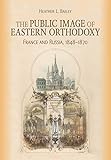The Public Image of Eastern Orthodoxy : France and Russia, 1848–1870 / Heather L. Bailey.
Material type: TextSeries: NIU Series in Orthodox Christian StudiesPublisher: Ithaca, NY : Cornell University Press, [2020]Copyright date: ©2021Description: 1 online resource (312 p.)Content type:
TextSeries: NIU Series in Orthodox Christian StudiesPublisher: Ithaca, NY : Cornell University Press, [2020]Copyright date: ©2021Description: 1 online resource (312 p.)Content type: - 9781501749513
- 9781501749537
- 281.947 23
- BX491 .B35 2021
- online - DeGruyter
| Item type | Current library | Call number | URL | Status | Notes | Barcode | |
|---|---|---|---|---|---|---|---|
 eBook
eBook
|
Biblioteca "Angelicum" Pont. Univ. S.Tommaso d'Aquino Nuvola online | online - DeGruyter (Browse shelf(Opens below)) | Online access | Not for loan (Accesso limitato) | Accesso per gli utenti autorizzati / Access for authorized users | (dgr)9781501749537 |
Browsing Biblioteca "Angelicum" Pont. Univ. S.Tommaso d'Aquino shelves, Shelving location: Nuvola online Close shelf browser (Hides shelf browser)

|

|

|

|

|

|

|
||
| online - DeGruyter The Chinese Revolution on the Tibetan Frontier / | online - DeGruyter The Greek Orthodox Church in America : A Modern History / | online - DeGruyter Kissinger and Latin America : Intervention, Human Rights, and Diplomacy / | online - DeGruyter The Public Image of Eastern Orthodoxy : France and Russia, 1848–1870 / | online - DeGruyter Information Technology and Military Power / | online - DeGruyter Confessions of a Free Speech Lawyer : Charlottesville and the Politics of Hate / | online - DeGruyter Who Wrote That? : Authorship Controversies from Moses to Sholokhov / |
Frontmatter -- Contents -- Acknowledgments -- Notes on Terminology and Transliteration -- Introduction -- 1. Roman Catholicism, Russian Orthodoxy, and Russophobia in France, 1830–1856 -- 2. The Archpriest as Publicist and Polemicist -- 3. The “Byzantine Firework” of Paris -- 4. A Spectacular Success: The Paris Church, the Russian Orthodox Press, and the Public Image of Orthodoxy -- 5. The Church Chained to the Throne of the “Czar” -- 6. Guettée, Vasiliev, L’Union chrétienne, and the Public Image of Orthodoxy -- Conclusion -- Notes -- Selected Bibliography -- Index
restricted access online access with authorization star
http://purl.org/coar/access_right/c_16ec
Focusing on the period between the revolutions of 1848-1849 and the First Vatican Council (1869-1870), The Public Image of Eastern Orthodoxy explores the circumstances under which westerners, concerned about the fate of the papacy, the Ottoman Empire, Poland, and Russian imperial power, began to conflate the Russian Orthodox Church with the state and to portray the church as the political tool of despotic tsars.As Heather L. Bailey demonstrates, in response to this reductionist view, Russian Orthodox publicists launched a public relations campaign in the West, especially in France, in the 1850s and 1860s. The linchpin of their campaign was the building of the impressive Saint Alexander Nevskey Church in Paris, consecrated in 1861. Bailey posits that, as the embodiment of the belief that Russia had a great historical purpose imextricably tied to Orthodoxy, the Paris church both reflected and contributed to the rise of religious nationalism in Russia that followed the Crimean War. At the same time, the confrontation with westerners' negative ideas about the Eastern Church fueled a reformist spirit in Russia while contributing to a better understanding of Eastern Orthodoxy in the West.
Mode of access: Internet via World Wide Web.
In English.
Description based on online resource; title from PDF title page (publisher's Web site, viewed 01. Dez 2022)


